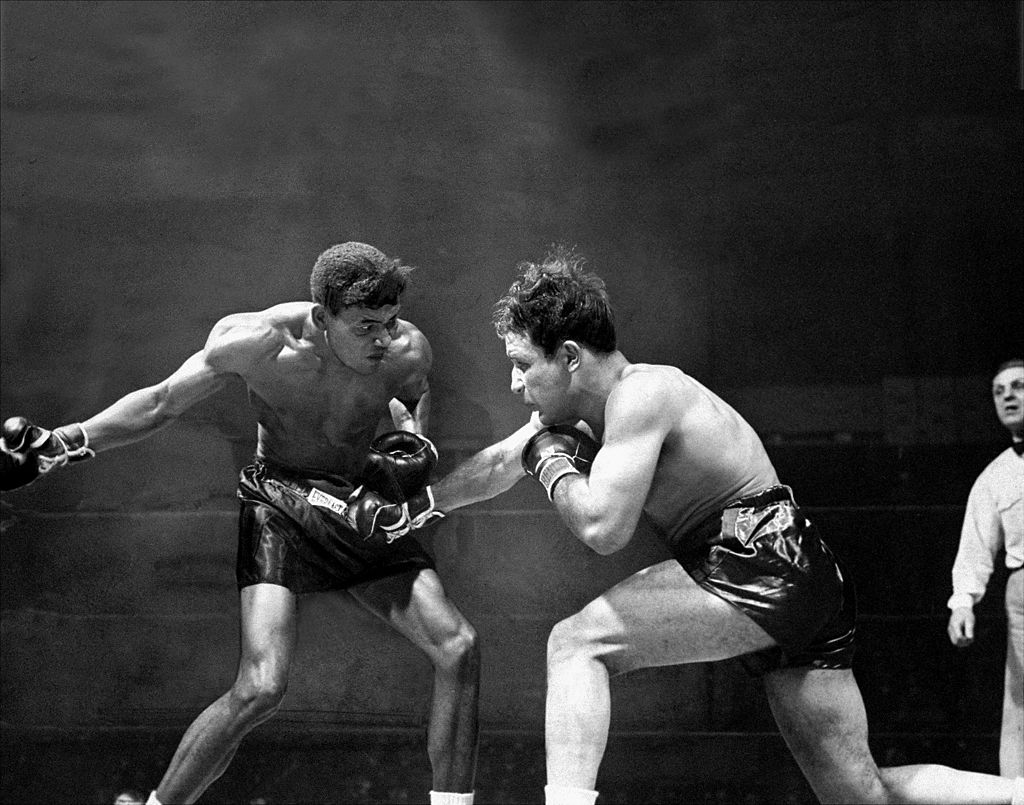Sports
Jake LaMotta and Sugar Ray Robinson: Boxing’s Best Rivalry

Younger fans understandably point to Muhammad Ali vs. Joe Frazier as the best rivalry in boxing, but Jake LaMotta and Sugar Ray Robinson fought each other twice as often and with unrivaled intensity decades earlier.
Their six bouts from October 1942 to February 1951 all went the distance until their final showdown, a synergy of brutal pugilism and live television that came to be known as the St. Valentine’s Day Massacre.
Jake LaMotta and Sugar Ray Robinson were both champions
Jake LaMotta, portrayed by Robert De Niro in the 1980 biographical film Raging Bull, was a punishing fighter specializing in close-in combat and body blows rather than knockouts. He compiled an 83-19-4 record from 1951 to 1954 with 30 knockouts and was never sent to the canvas until his 103rd fight.
LaMotta’s 89th fight was his first title shot and he won the welterweight championship over Marcel Cerdan in 1949 when the champion didn’t come out for the 10th round. His reign lasted until the final showdown 14 months later with Sugar Ray Robinson.
Robinson earned titles in two weight classes while compiling a 173-19-6 record with 110 knockouts between 1940 and 1965. He was mobile and picked his spots to land combinations that set up the knockout blow. Robinson was unbeaten in 91 bouts from 1943 to 1951 and captured the middleweight title five times, contributing to his selection in 2002 by The Ring magazine as the No. 1 fighter of the past 80 years.
The common denominator for the two fighters with contrasting styles was that they were both so feared by top contenders that they became their most reliable opponents. Robinson won five of their six meetings, but their clashing styles led to competitive contests each time.
“No foul blows or nothing when we fought,” LaMotta said. “We stood there toe-to-toe and banged away. He was the real greatest.”
Five bouts between titans and five decisions
Sugar Ray Robinson vs. Jake LaMotta had more sequels – and better drama – than Sylvester Stallone’s Rocky movies.
Robinson’s first loss in 126 amateur and pro fights came at LaMotta’s hands in their second head-to-head confrontation. LaMotta scored a knockdown in the first round of their first bout only to see Robinson win by unanimous decision, so literally sending him through the ropes in the eighth round of the rematch – Sugar Ray was saved by the bell — four months later in a unanimous decision set up a grudge match just three weeks later.
That third bout saw LaMotta drop Robinson, who was being inducted into the Army the following day, for a nine-count in the seventh round only to lose another decision. They renewed their rivalry two years later in Madison Square Garden, where Robinson scored a unanimous decision.
The fifth matchup between LaMotta and Robinson was easily the most controversial. Fighting in Comiskey Park in Chicago on Sept. 26, 1945, Robinson was awarded a split decision that he called the toughest fight he’d had with LaMotta. Many in attendance were convinced that LaMotta should have been awarded the decision.
After so many matches against each other in a short span, Robinson and LaMotta went their separate ways for more than five years. Robinson continued mowing down opponents and took his first championship belt in December 1946. LaMotta went on a 20-3-1 run to earn his successful title shot against Marcel Cerdan.
The St. Valentine’s Day Massacre
Robinson was finding it increasingly difficult to make 147 pounds a decade into his pro career. That and LaMotta’s perseverance in finally earning the middleweight title prompted Robinson to move up a class for the sixth match between the men.
The Feb. 14, 1951, fight was held at Chicago Stadium and televised as boxing became one of the first sports to embrace the medium as the promotional tool that it was. What ensued was one of the most talked-about fights of the century. Drained by having to cut weight a day earlier, LaMotta went for the early knockout. He had Robinson hurt in the sixth round but couldn’t finish him off and not long afterward found himself wearing down.
Ahead on points, Robinson stalked LaMotta for a late knockout with punches that ended fights against lesser opponents. LaMotta hung tough, stayed on his feet and even managed to drive Robinson to the ropes late in the 12th round. But Robinson countered with a flurry and escaped the round.
LaMotta was under siege in the 13th round and reached the point of being unable to defend himself. The referee stopped the fight, giving Robinson the victory and the middleweight championship. The loss all but spelled the end of LaMotta’s career as he would win just five of his final 10 bouts.











